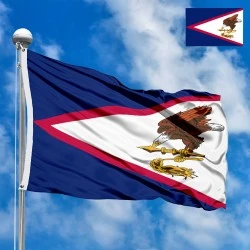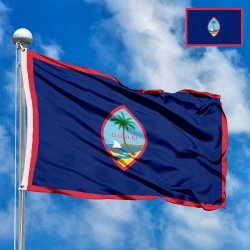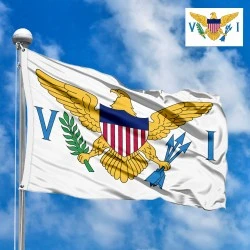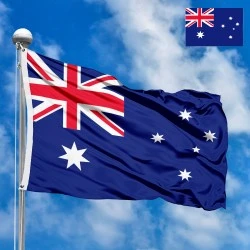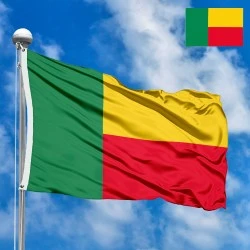Flag of the United States of America (USA)
- Flag Type: State
- Proportions (official): 10:19
- Official name: United States of America
- Local name: United States of America
- Sovereignty (year): YES (1776)
- Member of Organizations: UN, NATO, Organization of American States, Pacific Community
- Country code, territory: US, USA, 840
- Capital: Washington, D.C.
- Large cities: New York, Los Angeles, Chicago
- Population: ~341,800,000 (2024, UN)
- Religions: Christianity ~63%, non-religious ~28%
- Area (km²): 9 833 520
- Highest point: Denali (6,190 m)
- Lowest point: Death Valley (-86 m)
- Currency: United States dollar (USD, $)
- Languages: English
- Dialing code: +1
- National domain: .us
Flag Information
General information
Demography and Culture
Economy and communications
- All Flags
- Flags of Countries by Continent
-
Flags of Organizations
- Flags of UN countries
- Flags of the European Union countries
- Flags of NATO countries
- Flags of the countries of the Organization of Islamic Cooperation
- Flags of the countries of the Organization of American States
- Flags of the Arab League countries
- Flags of the African Union countries
- Flags of the countries of the Union of South American Nations
- Flags of the Commonwealth of Nations
- Flags of the countries of the Secretariat of the Pacific Community
- Flags of the Nordic Council countries
- Flags of the Caribbean Community
- Flags of the countries of the Association of Southeast Asian Nations
- Flags of the East African Community
- Flags of the countries of the Organization of Turkic States
- LGBT Community Flags
- Historical Flags
- Ethnic Flags
- Flags of the USA (states)
Description
The American Flag, a symbol of freedom, unity, and resilience, is perhaps the most recognizable emblem of the United States. Affectionately known as the "Stars and Stripes," "Old Glory," or the "Star-Spangled Banner," its design is a powerful and poignant narrative of the nation's journey from thirteen rebellious colonies to a global superpower. Its presence is woven into the very fabric of American life, from solemn government buildings to vibrant community parades.
Physical Description and Symbolism
The flag’s design is a testament to its history. It features thirteen horizontal stripes, seven red and six white, which represent the original thirteen colonies that declared independence from Great Britain. The stripes alternate, beginning and ending with red. In the upper-left corner, a deep blue rectangle, known as the canton or "union," contains fifty white, five-pointed stars arranged in nine offset horizontal rows. Each star represents a state in the Union.
The colors are not merely decorative; they are deeply symbolic. As described by Charles Thomson, Secretary of the Continental Congress, upon the adoption of the Great Seal of the United States in 1782, the colors convey specific virtues:
-
Red (PMS 193C, Old Glory Red) signifies hardiness and valor. It is a tribute to the courage and sacrifice of those who have fought for the nation's freedoms.
-
White (White) represents purity and innocence, embodying the nation's high ideals and commitment to a new beginning free from tyranny.
-
Blue (PMS 282C, Old Glory Blue) stands for vigilance, perseverance, and justice. This color represents the enduring spirit and watchfulness required to maintain a just and free society.
Dimensions and Proportions
While flags of various sizes are common, the official specifications are precise and governed by a specific ratio. The hoist (width) of the flag is designated as 1.0, while the fly (length) is 1.9. The canton occupies the upper portion of the flag, with a hoist of exactly seven stripes (7/13 of the total hoist) and a fly of 0.76 (2/5 of the total fly). The stars are arranged in a specific pattern to ensure uniformity and represent the equality of all states. The diameter of each star is 4/5 of the width of a single stripe.
A History of Evolution and Change
The American flag’s story is a chronicle of a nation in constant growth and change. Its roots can be traced back to the Grand Union Flag of 1775, which had thirteen red and white stripes but still featured the British Union Jack in its canton. This flag, sometimes called the Cambridge Flag, symbolized the colonies' unity while still acknowledging their allegiance to the British Crown.
The pivotal moment arrived on June 14, 1777, when the Continental Congress passed the first Flag Resolution. It declared: "Resolved, That the flag of the thirteen United States be thirteen stripes, alternate red and white; that the union be thirteen stars, white in a blue field, representing a new constellation." This resolution gave birth to the first "Stars and Stripes," though the arrangement of the stars was not specified. The famous legend of Betsy Ross creating the first flag with a circular star pattern is a beloved part of American folklore, but it lacks historical documentation.
As new states joined the Union, the flag changed. A significant change occurred in 1795 when two new states—Vermont and Kentucky—were added, leading to a flag with fifteen stars and fifteen stripes. This design, which flew for 23 years, inspired Francis Scott Key to write "The Star-Spangled Banner" during the Battle of Fort McHenry in 1814.
In 1818, recognizing the impracticality of adding a new stripe for every new state, Congress passed a new Flag Act. It restored the flag to its original thirteen stripes and mandated that a new star be added for each new state on the July 4th following its admission. This established the permanent design principle that continues to this day. The current 50-star flag was officially adopted on July 4, 1960, after Hawaii became the 50th state in 1959. Interestingly, this design was created by a 17-year-old high school student, Robert G. Heft, for a school project.
Meaning and Significance for Citizens
For Americans, the flag is more than a piece of cloth; it is a profound symbol of national identity and the ideals upon which the country was founded. It represents the sacrifices of veterans and service members, the struggle for civil rights, and the pursuit of the American Dream. It is a visual representation of the nation’s core values: liberty, justice, and equality.
The flag’s meaning is deeply personal to many. It evokes a sense of pride and patriotism, a feeling of belonging to a shared national community. It is a unifying symbol in times of both celebration and mourning. When the flag is flown at half-staff, it is a national expression of sorrow and respect. When it is raised, it is a testament to the nation’s enduring strength and hope.
Interesting Facts
-
The current 50-star flag is the longest-serving version of the American flag, having been in use for over six decades.
-
The flag has been to the moon! It was famously planted by Neil Armstrong and Buzz Aldrin during the Apollo 11 mission in 1969.
-
There are specific rules for displaying the flag, known as the U.S. Flag Code, which details how to properly handle, display, and even dispose of a flag with dignity.
-
The reverse side of the Great Seal of the United States, adopted in 1782, features an eagle holding a scroll with the motto "E pluribus unum" — Latin for "Out of many, one," a principle perfectly embodied by the flag itself.
The American flag stands as a timeless reminder of the nation's past, its present, and its promise for the future. It is a beacon of hope and a symbol of the enduring spirit of the American people.
In the demonstration images, full-size flags are shown with proportions of 2:3, and hand-held flags with proportions of 1:2.
Donation
Download
Completely free for commercial and non-commercial use (public domain).
You can freely use them in your news magazines, websites, software, mobile applications.
We appreciate a backlink to https://flagssite.com
Raster files - Flag of the United States of America (USA) (PNG, JPG)
 Waving flag
Waving flag
- PNG format (transparent background), 72dpi, dimensions in Pixels (px), aspect ratio 3:4.
- 15х20 px
- 30х40 px
- 60х80 px
- 120x160 px
- 240x320 px
 Sizes:
Sizes:
"v15" - image size (by height); if necessary, replace with available: v15, v30, v60, v120, v240.
!!! For resizing, use the Latin (eng) keyboard layout.
<img src="https://flagssite.com/flags/v15/20521.png" alt="Flag of the United States of America (USA)">
 Round flag
Round flag
- PNG format (transparent background), 72dpi, dimensions in Pixels (px), aspect ratio 1:1.
"d15" - image size (diameter); if necessary, replace with available: d15, d30, d60, d120, d240.
!!! For resizing, use the Latin (eng) keyboard layout.
<img src="https://flagssite.com/flags/d15/20521.png" alt="Flag of the United States of America (USA)">
 Rectangular flag 2:3
Rectangular flag 2:3
- JPG format, 72dpi, dimensions in Pixels (px), aspect ratio 2:3.
"h30" - image size (by height); if necessary, replace with available: h15, h30, h60, h120, h240, h360, h480.
!!! For resizing, use the Latin (eng) keyboard layout.
<img src="https://flagssite.com/flags/h30/20521.jpg" alt="Flag of the United States of America (USA)">


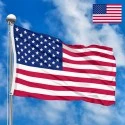




 Sizes:
Sizes:
 Sizes:
Sizes:
